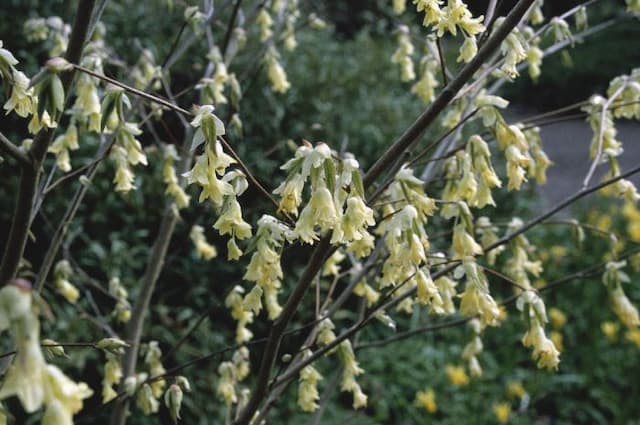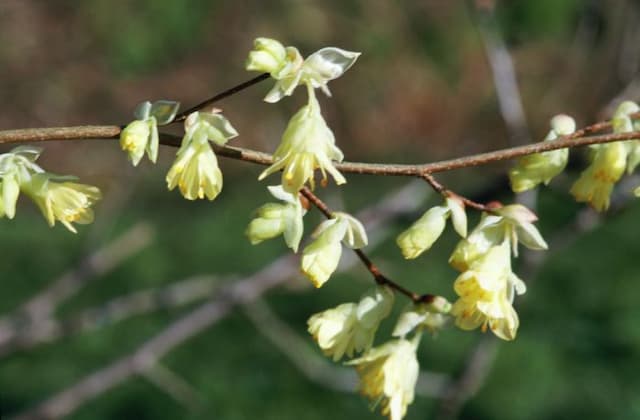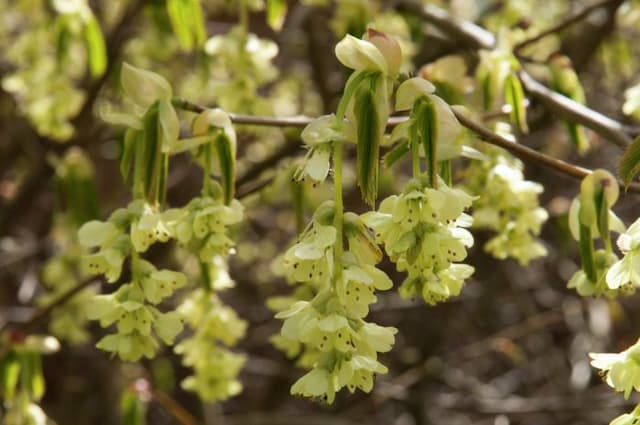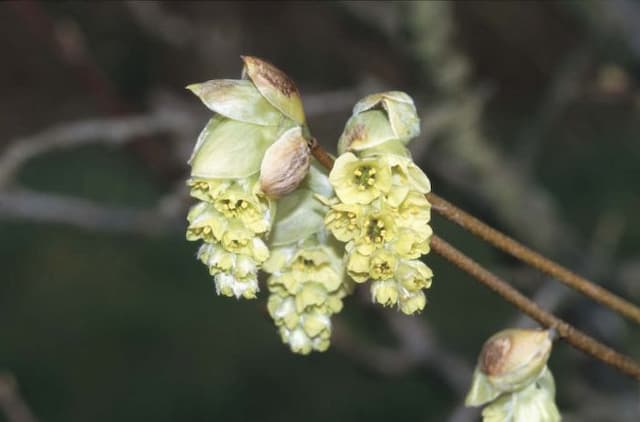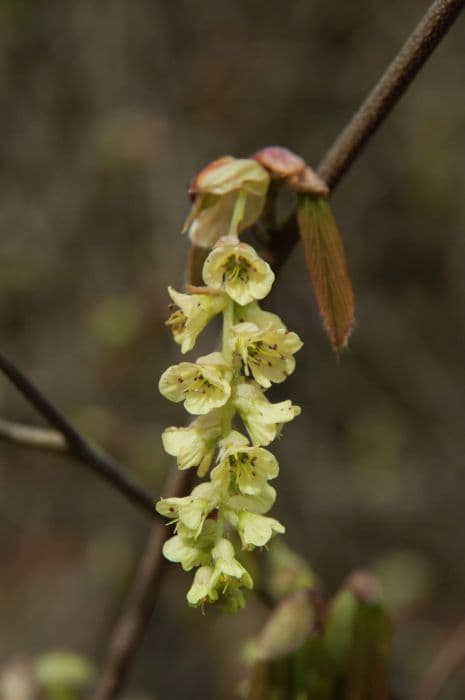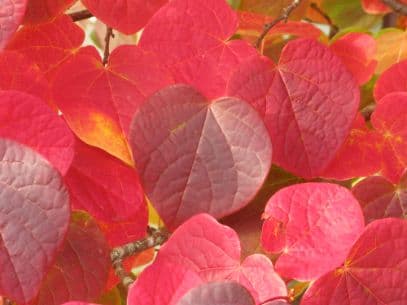Witch Hazel Hamamelis × intermedia 'Sunburst'

ABOUT
The plant known as 'Sunburst' is a striking variety that is most famous for its vibrant show of flowers. Unlike many plants, it blooms in the late winter to early spring, providing a burst of color when the landscape is still quite barren. The flowers are unique; ribbon-like petals burst forth in a bright yellow hue that is both cheerful and somewhat fragrant. These blossoms cover the branches, creating a dramatic contrast against the winter backdrop. The foliage of 'Sunburst' comes after the flowers and is also quite attractive. The leaves are oval to broad-oval, with a smooth texture and a somewhat wavy margin. They emerge a reddish-purple color in the spring, then change to a dark green as they mature. In the fall, the leaves turn a vibrant yellow, providing extended seasonal interest even after the flowers have disappeared. The branches of 'Sunburst' are relatively stout and spread outwards, forming a vase-shaped structure that provides an aesthetically pleasing shape throughout the year. In winter, the exposed branches create an intricate pattern that adds structural beauty to the garden. 'Sunburst' is a robust plant that can add a dynamic element to gardens with its year-round interest, from the bright flowers in late winter to the attractive foliage through the growing season and the fall color before leaf drop.
About this plant
 Names
NamesSynonyms
Witch Hazel, Hybrid Witch Hazel, Sunburst Witch Hazel
Common names
Hamamelis × intermedia 'Sunburst'.
 Toxicity
ToxicityTo humans
Witch Hazel 'Sunburst' is not known to be toxic to humans. Generally, Witch Hazel is considered safe and is even used in various skincare and medicinal products for its astringent properties. However, as with any plant, individuals may experience allergic reactions or skin sensitivities when coming into contact with the plant, especially if they have specific plant allergies. Ingesting Witch Hazel in large quantities could potentially lead to stomach upset due to the tannins present, but typical household exposure is unlikely to cause serious harm.
To pets
Witch Hazel 'Sunburst' is not known to be toxic to pets. Witch Hazel plants are generally considered non-toxic to both cats and dogs. While ingestion of large amounts could potentially cause mild stomach upset due to its astringent properties, it is unlikely to cause serious illness. However, pet owners should still discourage their pets from eating plants, as individual animals might have different sensitivities or allergic reactions to plants they come into contact with.
 Characteristics
CharacteristicsLife cycle
Perennials
Foliage type
Deciduous
Color of leaves
Green
Flower color
Yellow
Height
10-15 feet (3-4.5 meters)
Spread
10-15 feet (3-4.5 meters)
Plant type
Shrub
Hardiness zones
5-8
Native area
Asia
Benefits
 General Benefits
General Benefits- Ornamental Value: Hamamelis × intermedia 'Sunburst', commonly known as Witch Hazel, has vibrant yellow flowers which add color to gardens in late winter to early spring when few other plants are in bloom.
- Wildlife Attraction: The flowers provide nectar for early-emerging pollinators such as bees.
- Seasonal Interest: Witch Hazel offers multi-season interest with its unique flowering time, attractive fall foliage, and distinctive seed pods in the summer.
- Drought Tolerance: Once established, it is relatively drought-tolerant, requiring minimal watering in many conditions.
- Low Maintenance: It typically requires minimal pruning and is generally pest and disease resistant, making it easy to care for.
- Tolerance to Various Soil Conditions: Witch Hazel adapts well to a range of soil types, although it prefers well-drained, loamy soils.
- Shade Tolerance: This plant can tolerate partial shade, making it a versatile choice for garden design.
 Medical Properties
Medical PropertiesThis plant is not used for medical purposes.
 Air-purifying Qualities
Air-purifying QualitiesThis plant is not specifically known for air purifying qualities.
 Other Uses
Other Uses- Witch Hazel 'Sunburst' branches can be used in flower arrangements, particularly in winter when its bright yellow flowers provide a cheerful splash of color.
- The dried petals of the Witch Hazel 'Sunburst' can be used in potpourri to add a mild, pleasant fragrance and a unique texture to the mix.
- Witch Hazel 'Sunburst' can be planted as a natural privacy screen or hedge because of its dense growth habit.
- The plant serves as a support for climbing plants or vines, offering them a sturdy structure to grow upon.
- Witch Hazel 'Sunburst' can be used in witchcraft or spiritual practices, where branches might be fashioned into divining rods or used in rituals.
- In woodworking, the strong wood of Witch Hazel 'Sunburst' can be used to create small wooden crafts or carvings.
- The blooms can be pressed and included in botanical art or herbarium collections for educational purposes.
- During autumn, the foliage of Witch Hazel 'Sunburst' provides ornamental value to landscapes due to its vibrant, colorful leaves.
- As a photography subject, the distinctive flowers and form of Witch Hazel 'Sunburst' are often captured by nature photographers.
- The Witch Hazel 'Sunburst' can be grown as a specimen plant in arboretums or botanic gardens for study and preservation of the variety.
Interesting Facts
 Feng Shui
Feng ShuiThe Witch Hazel is not used in Feng Shui practice.
 Zodiac Sign Compitability
Zodiac Sign CompitabilityThe Witch Hazel is not used in astrology practice.
 Plant Symbolism
Plant Symbolism- Healing: Commonly known as witch hazel, Hamamelis × intermedia 'Sunburst' is often associated with healing due to the plant's medicinal properties.
- Magic: The name "witch hazel" suggests a historical connection to folk magic and the use of its branches as divining rods.
- Protection: In some cultures, witch hazel is believed to offer protection against negative energies and evil spirits.
- New Beginnings: The early blooming of witch hazel flowers in the year symbolizes fresh starts and the first stirrings of life after winter.
- Adaptability: Witch hazel's ability to thrive in various conditions reflects the qualities of resilience and adaptability.
 Water
WaterThe Witch Hazel 'Sunburst' should be watered deeply but infrequently to encourage a strong, deep root system. Water this plant with about 1 to 1.5 gallons of water every week during dry spells, and reduce the frequency during periods of natural rainfall. The exact amount may vary depending on your climate and soil type, but the goal is to keep the soil consistently moist but not waterlogged. In particularly hot or windy weather, you may need to water a little more frequently, whereas cooler, cloudy conditions might mean less frequent watering is needed. When watering, aim to apply the water directly to the soil rather than spraying the foliage, to reduce the risk of fungal diseases.
 Light
LightWitch Hazel 'Sunburst' prefers full sun to partial shade to thrive. It should be planted in a location where it receives at least four to six hours of direct sunlight daily, though some afternoon shade can be beneficial in hotter climates. Avoid deep shade, as this will result in fewer flowers and a leggier growth habit.
 Temperature
TemperatureWitch Hazel 'Sunburst' can tolerate a range of temperatures once established. The ideal conditions are between 60 and 75 degrees Fahrenheit; however, it can withstand temperatures down to about 0 degrees Fahrenheit during winter dormancy and can handle summer highs up to about 90 degrees Fahrenheit. Extreme temperature fluctuations should be avoided to prevent stress to the plant.
 Pruning
PruningWitch Hazel 'Sunburst' should be pruned to remove any dead or damaged wood and to maintain an attractive shape. Pruning is best done in late winter or early spring after the flowering period has finished, as this plant blooms on the previous season's growth. You can also prune to thin out dense branches, which improves air circulation and the plant’s overall form. Pruning should be done sparingly, as heavy pruning can reduce flowering.
 Cleaning
CleaningAs needed
 Soil
SoilWitch Hazel 'Sunburst' prefers well-drained, loamy soil enriched with organic matter. A slightly acidic to neutral pH of 5.5 to 7 is ideal. Amend soil with compost or leaf mold to enhance fertility and structure.
 Repotting
RepottingWitch Hazel 'Sunburst' is typically grown outdoors and is not commonly repotted. If container-grown, repot every 2 to 3 years during dormant season if growth is restricted.
 Humidity & Misting
Humidity & MistingWitch Hazel 'Sunburst' is tolerant of a range of humidity levels and does not require high humidity; average outdoor conditions are typically sufficient.
 Suitable locations
Suitable locationsIndoor
Not ideal for indoor growth; prefers outdoor conditions.
Outdoor
Plant in sun or part shade in well-drained soil.
Hardiness zone
5-8 USDA
 Life cycle
Life cycleHamamelis × intermedia 'Sunburst', commonly known as Witch Hazel 'Sunburst', begins its life cycle with germination, which occurs when the seed finds suitable soil and climate conditions, usually in early spring or late winter. Following germination, the seedling emerges, and the young plant undergoes a growth phase, developing a strong root system and foliage. As it matures, Witch Hazel 'Sunburst' enters into a vegetative state, producing distinctive large, yellow flowers, which are remarkable for blooming during late winter to early spring, often before the leaves fully emerge. After flowering, the plant enters a pollination stage, where the flowers can be fertilized by wind or insects, leading to the formation of fruit that contains the seeds. The fruit ripens in late summer or autumn, eventually opening to disperse seeds, completing the reproductive cycle. Witch Hazel 'Sunburst' can live for many years, and the mature plant continues to grow and undergo seasonal cycles of flowering and seed production, maintaining its life cycle.
 Propogation
PropogationPropogation time
Late Winter to Early Spring
The most popular method to propagate Witch Hazel 'Sunburst' is via softwood cuttings. This technique involves taking cuttings from new growth in late spring or early summer when the stems are still tender and flexible. A cutting should be about 4 to 6 inches (10 to 15 cm) long, with several leaf nodes. The lower leaves are removed and the cut end is often dipped in rooting hormone to encourage root development. The prepared cutting is then inserted into a well-draining potting medium, such as a mix of peat and perlite. It's important to maintain high humidity around the cutting, which can be achieved by covering the pot with a plastic bag or placing it in a propagator. Roots typically develop within a few weeks, after which the new plants can be gradually acclimated to less humid conditions before being planted out.
